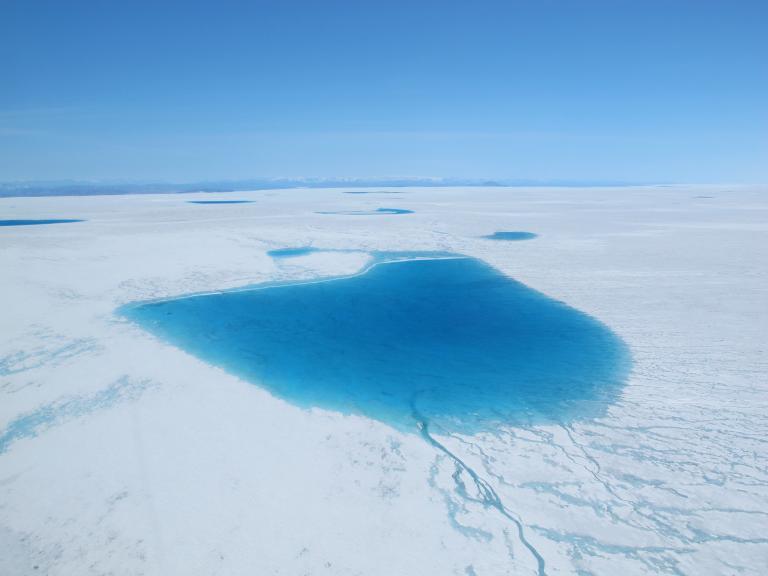
Lead supervisor: Ian Willis, Scott Polar Research Institute
Co-supervisor: Neil Arnold, Scott Polar Research Institute
Brief summary:
Leveraging satellite-derived surface velocity data sets, modelled runoff, and calculations of lake drainage volumes to investigate hydrological controls on the flow of the Greenland Ice Sheet.
Importance of the area of research concerned:
The Greenland Ice Sheet (GrIS) is likely to contribute ~ 10 cm to sea level over the C21st. It currently loses around half its mass through surface melt and runoff, and half through outlet glacier flow to the ocean. Understanding the processes that control GrIS flow, particularly basal sliding, is essential for quantifying future rates of sea level. Sliding is controlled by surface runoff, how water is delivered to the bed, and the extent to which the basal drainage system remains in a high pressure distributed state or evolves to a low pressure channelised configuration. Despite the wealth of recent investigations into GrIS hydro-dynamic coupling, questions remain regarding: the importance of lake drainages in driving water pressure and sliding changes in the short vs longer term; whether rapid lake drainages involving hydro-fracture and new moulin creation drive subglacial channelisation and summer slowdown; whether marked summer slowdown necessarily equates to lower annual speeds; and whether lake drainages, subglacial drainage system development, and sliding speeds in one year, affect those in subsequent years – the extent to which there is ‘interannual subglacial memory’.
Project summary :
Two freely available GrIS-wide datasets will be used: 1. Satellite derived velocity data (e.g., ESA’s Climate Change Initiative, NASA's MEaSUREs programme, the ITS_LIVE project, the Programme for Monitoring of the Greenland Ice Sheet (PROMICE)); 2. Surface runoff data derived from climate models (e.g., Modèle Atmosphérique Régionale (MAR), Regional Atmospheric Climate Model (RACMO)). This project will derive lake drainage data from optical and SAR imagery and a lake drainage algorithm, FASTER (Williamson et al, 2018). Statistical techniques will be used to examine the relationships between these variables over seasonal and inter-annual timescales across the land-terminating parts of the GrIS. The project will examine how lake drainage events and the subsequent routing of surface runoff to the bed drive seasonal and annual speedup or slowdown across the ice sheet and from year to year.
What will the student do?:
The student will evaluate the published GrIS surface velocity and surface runoff datasets to map monthly to annual surface velocity variations and runoff across the ice sheet over the last approx. decade. A Surface Routing and Lake Filling algorithm (SRLF) (Arnold et al, 2014) will be used to accumulate runoff across an ice sheet surface DEM to calculate lake volume increases and a lake drainage algorithm (FASTER) (Williamson et al, 2018) will be used to calculate changing lake volumes from satellite imagery and their drainage characteristics – timing, duration, and volume. The output of FASTER will be used to parameterize a lake drainage component to SRLF, to calculate lake drainage events over the ice sheet through time, not just when there is available satellite imagery. Visualization and statistical techniques will be developed to quantify how runoff, lake drainages and the delivery of water to the ice sheet bed influence glacier velocities over monthly to annual timescales. They will also be used to examine additional influences on velocity changes such as ice thickness, and whether this influence is consistent from year to year or if there is ‘interannual subglacial memory’.
References - references should provide further reading about the project:
Davison, B.J., Sole, A.J., Livingstone, S.J., Cowton, T.R. and Nienow, P.W., 2019. The influence of hydrology on the dynamics of land-terminating sectors of the Greenland ice sheet. Frontiers in Earth Science, 7, p.10. doi.org/10.3389/feart.2019.00010
Williamson, A.G., Banwell, A.F., Willis, I.C. and Arnold, N.S., 2018. Dual-satellite (Sentinel-2 and Landsat 8) remote sensing of supraglacial lakes in Greenland. Cryosphere, v. 12, p.3045-3065. doi:10.5194/tc-12-3045-2018.
Arnold, N.S., Banwell, A.F. and Willis, I.C., 2014. High-resolution modelling of the seasonal evolution of surface water storage on the Greenland Ice Sheet. The Cryosphere, v. 8, p.1149-1160. doi:10.5194/tc-8-1149-2014.
Applying
You can find out about applying for this project on the Scott Polar Research Institute page.